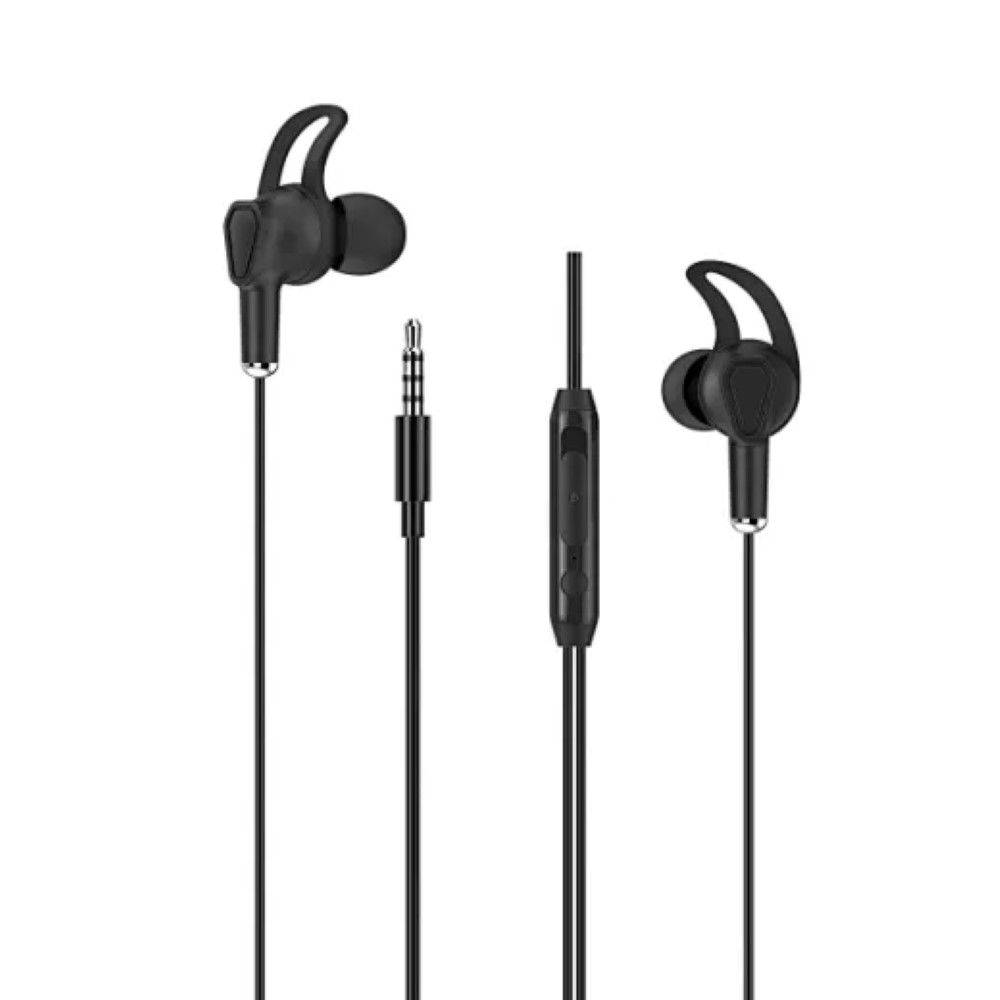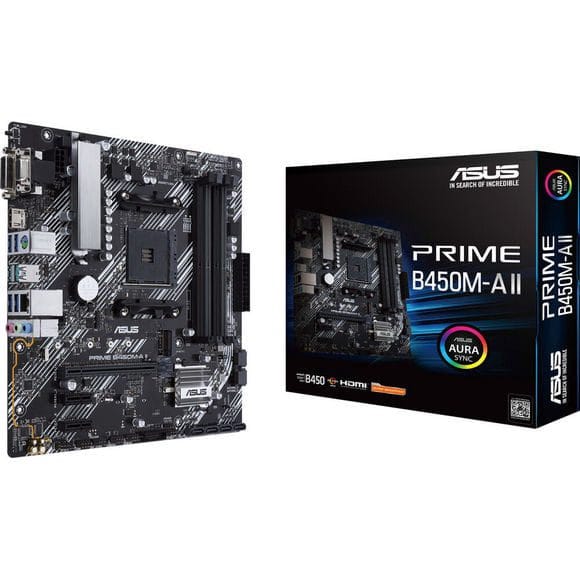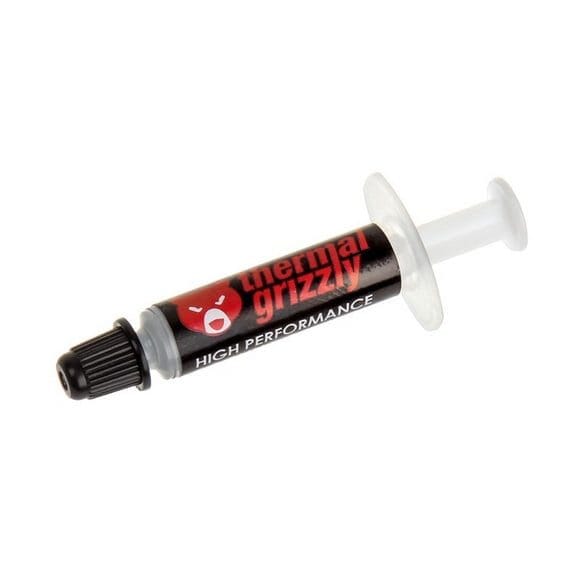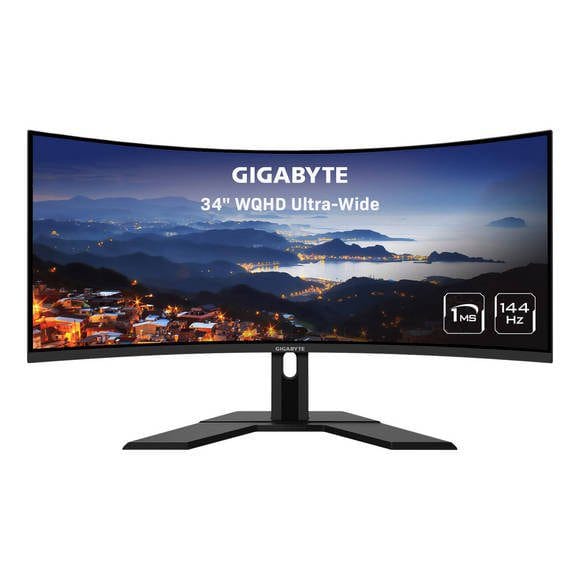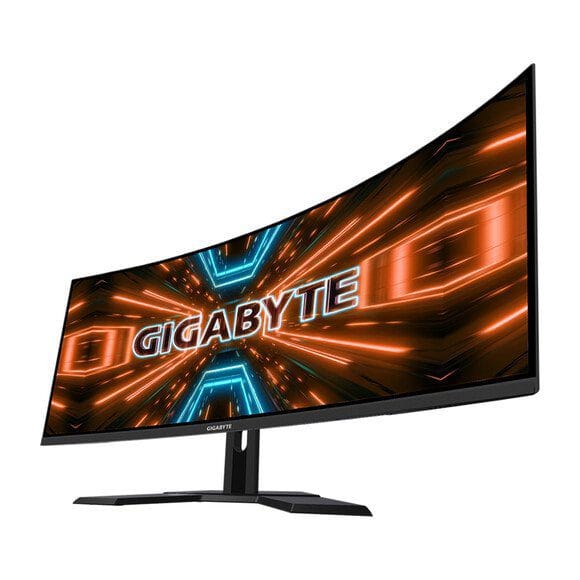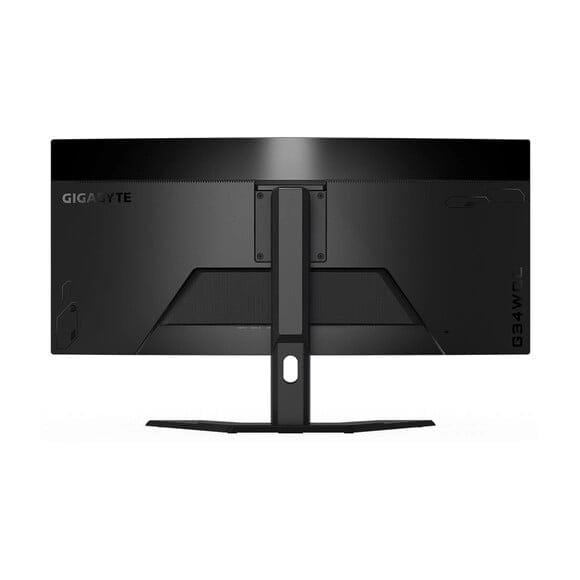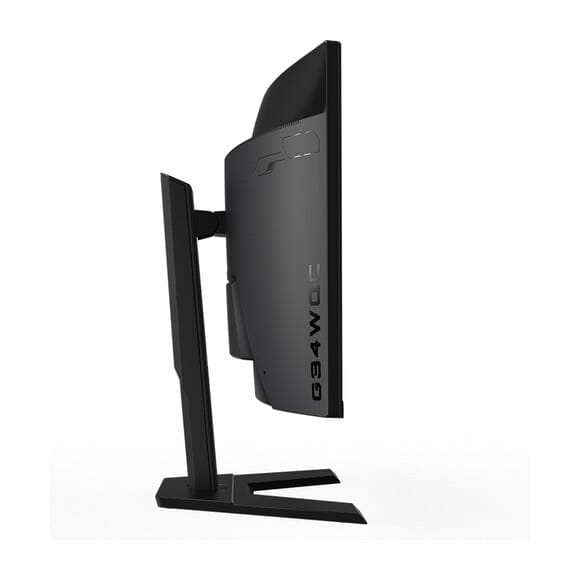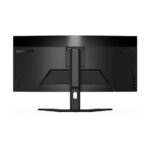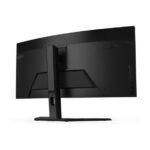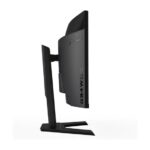Gigabyte G34WQC-A 34″ 144Hz Ultra-Wide Curved Gaming Monitor, 3440 x 1440 VA 1500R Display, 1ms (MPRT) Response Time, 90% DCI-P3, VESA Display HDR400, FreeSync Premium, Black Price in Pakistan
| Brand
Name of the company-manufacturer. |
Gigabyte |
| Model
Designation of the model. |
G34WQC A |
| Model year
The year in which this model was announced. |
2022 |
Display
Information about the main characteristics of the display – panel, backlight, resolution, refresh rate, etc.
| Size class
Size class of the display as declared by the manufacturer. Often this is the rounded value of the actual size of the diagonal in inches. |
34 in (inches) |
| Diagonal
Approximate diagonal size of the display. If the manufacturer does not provide such information, the diagonal is calculated from the width and height of the screen. |
863.6 mm (millimeters) 86.36 cm (centimeters) 34 in (inches) 2.8333 ft (feet) |
| Width
Approximate width of the display. If the manufacturer does not provide such information, the width is calculated from the diagonal and the aspect ratio. |
797.22 mm (millimeters) 79.722 cm (centimeters) 31.3866 in (inches) 2.6156 ft (feet) |
| Height
Approximate height of the display. If the manufacturer does not provide such information, the height is calculated from the diagonal and the aspect ratio. |
333.72 mm (millimeters) 33.372 cm (centimeters) 13.1386 in (inches) 1.0949 ft (feet) |
| Radius of curvature
There are curved displays, whose curve is part of a circumference (arc). In order to give more precise information about the curve of the screen, often the manufacturer provides data about the radius of this circumference. The smaller the radius, the larger the screen curve. |
1500 mm (millimeters) 150 cm (centimeters) 59.0551 in (inches) 4.9213 ft (feet) |
| Panel type
There are various panel technologies. Each has its own specific features – viewing angles, color reproduction, response time, brightness/contrast, production cost, etc. The image quality depends directly on the type of the display panel used. |
VA |
| Panel bit depth
The most widely used panels are those with 6, 8, and 10 bits for each of the RGB components of the pixel. They provide 18-, 24-, and 30-bit color, respectively. |
8 bits |
| FRC
Frame Rate Control (FRC) is a method, which allows the pixels to show more color tones. With quick cyclic switching between different color tones, an illusion for a new intermediate color tone is created. For example, by using FRC, a 6-bit display panel is able to show 16.7 millioin colors, which are typical for 8-bit display panels, and not the standard 262200 colors, instead. There are different FRC algorithms. |
No |
| Colors
The maximum number of colors, which the display is able to reproduce, depends on the type of the panel in use and color enhancing technologies like FRC. |
16777216 colors 24 bits |
| Aspect ratio
The ratio between the horizontal and the vertical side of the display. Some of the standard and widely used aspect ratios are 4:3, 5:4, 16:9 and 16:10. |
2.389:1 |
| Resolution
Information about the number of pixels on the horizontal and vertical side of the screen. A higher resolution allows the display of a more detailed and of higher quality image. |
3440 x 1440 pixels |
| Pixel pitch
The pixel pitch shows the distance from the centers of two neighboring pixels. In displays, which have a native resolution (the TFT ones, for example), the pixel pitch depends on the resolution and the size of the screen. |
0.232 mm (millimeters) 0.0232 cm (centimeters) 0.0091 in (inches) 0.0008 ft (feet) |
| Pixel density
Information of the number of pixels in a unit of length. With the decrease of the display size and the increase of its resolution, the pixel density increases. |
109 ppi (pixels per inch) 43 ppcm (pixels per centimeter) |
| Display area
The percentage of the approximate area, taken by the active part of the screen, to the total front area. |
90.5 % (percent) |
| Backlight
The backlight is the source of light of the LCD display panels. The type of backlight determines the image quality and the color space of the display. There are various backlights such as CCFL, LED, WLED, RGB-LED, and etc. |
W-LED |
| sRGB
sRGB is a color space, developed jointly by Hewlett-Packard and Microsoft in 1996. It is used in different devices such as printers, displays, TV sets, cameras, etc. The sRGB color space covers about 72% of the NTSC color space. |
120 % (percent) |
| Adobe RGB (1998)
Adobe RGB (1998) is a color space, developed by Adobe Systems in 1998. It has a wider gamut than the sRGB (mainly in the cyan-green range of colors) and is widely used in professional printing. |
85 % (percent) |
| DCI P3
DCI P3 is a color space, introduced in 2007 by the SMPTE. It is used in digital cinema and has a much wider gamut than the sRGB. |
90 % (percent) |
| Brightness
Information about the brightness of the screen. It is measured in candela per square metre (cd/m²). |
350 cd/m² (candela per square meter) |
| Static contrast
The static contrast shows the ratio between the brightest and the darkest color, which the display can reproduce simultaneously, for example, within one and the same frame/scene. |
4000 : 1 |
| Dynamic contrast
The dynamic contrast shows the ratio between the brightest and the darkest color, which the display can reproduce over time, for example, in the course of playing a video. |
12000000 : 1 |
| HDR
HDR expands the contrast ratio (peak luminance and minimal black levels) and color palette to achieve more details across the whole image – from the darkest parts to the brightest ones, which results in more realistic and life-like image. |
DisplayHDR 400 |
| Horizontal viewing angle
Information about the maximum horizontal viewing angle, within which the image on the screen is of acceptable quality. |
178 ° (degrees) |
| Vertical viewing angle
Information about the maximum vertical viewing angle, within which the image on the screen is of acceptable quality. |
178 ° (degrees) |
| Minimum response time
Information about the minimum amount of time, in which the pixels change from one color to another. Very often the manufacturer provides the response time for transition from grey-to-grey (G2G). |
4 ms (milliseconds) 0.0040 s (seconds) |
| Coating
Information about the type of coating of the display. There are different types of matte and glossy coatings, each of which has its own advantages and drawbacks. |
Anti-glare/Matte |
| Response time – 1 ms (MPRT – Motion Picture Response Time) |
3D
3D displays use various technologies to achieve a 3D effect. Each of these technologies has its own advantages and drawbacks.
| 3D
Information on whether 3D is supported or not. |
No |
Frequencies
Information about the horizontal and vertical refresh rates/frequencies.
| Vertical frequency (digital)
The vertical frequency/refresh rate shows how many times in a second the image on the screen is refreshed. |
48 Hz – 144 Hz (hertz) |
Power supply and consumption
Information about the power supply and consumption, energy efficiency class, etc.
| 110V
Permissible voltage tolerance in a 110-volt electric system. |
100 V – 120 V (volts) |
| 220V
Permissible voltage tolerance in a 220-volt electric system. |
220 V – 240 V (volts) |
| Alternating current frequency
Requirement regarding the alternating current frequency in the electric system. |
50 Hz – 60 Hz (hertz) |
| Power consumption (off)
Power consumption in off-mode. |
0.5 W (watts) |
| Power consumption (sleep)
Power consumption in sleep/stand by/suspend mode. |
0.5 W (watts) |
| Power consumption (maximum)
The maximum possible power consumption. |
80 W (watts) |
Dimensions, weight and color
Information about the dimensions and the weight of the specific model with and without stand as well as the colors, in which it is offered to the market.
| Width
Width without stand in different measurement units. |
808.89 mm (millimeters) 80.889 cm (centimeters) 31.8461 in (inches) 2.6538 ft (feet) |
| Height
Height without stand in different measurement units. |
363.45 mm (millimeters) 36.345 cm (centimeters) 14.3091 in (inches) 1.1924 ft (feet) |
| Depth
Depth without stand in different measurement units. |
114.45 mm (millimeters) 11.445 cm (centimeters) 4.5059 in (inches) 0.3755 ft (feet) |
| Width with stand
Width with stand in different measurement units. |
808.89 mm (millimeters) 80.889 cm (centimeters) 31.8461 in (inches) 2.6538 ft (feet) |
| Height with stand
Height with stand in different measurement units. |
388.79 mm (millimeters) 38.879 cm (centimeters) 15.3067 in (inches) 1.2756 ft (feet) |
| Depth with stand
Depth with stand in different measurement units. |
234.81 mm (millimeters) 23.481 cm (centimeters) 9.2445 in (inches) 0.7704 ft (feet) |
| Weight with stand
Weight with stand in different measurement units. |
8.4 kg (kilograms) 18.52 lbs (pounds) |
| Box width
Width of the package in different measurement units. |
938 mm (millimeters) 93.8 cm (centimeters) 36.9291 in (inches) 3.0774 ft (feet) |
| Box height
Height of the package in different measurement units. |
563 mm (millimeters) 56.3 cm (centimeters) 22.1654 in (inches) 1.8471 ft (feet) |
| Box depth
Depth of the package in different measurement units. |
272 mm (millimeters) 27.2 cm (centimeters) 10.7087 in (inches) 0.8924 ft (feet) |
| Box weight
Weight of the product with all accessories and packaging in different measurement units. |
12.1 kg (kilograms) 26.68 lbs (pounds) |
| Colors
Information about the colors, in which the specific model is offered to the market. |
Black |
Ergonomics
Information about the ergonomic functions – height adjustment, swivel angles, tilt angles, etc.
| VESA mount
Information about whether there is a possibility for wall mounting according to the VESA Mounting Interface Standard (MIS). |
Yes |
| VESA interface
There are many various interfaces under the VESA standard, which differ in the size of the brackets, the distances between the screw holes and their number. |
100 x 100 mm |
| Removable stand
Information about whether the stand can be dismounted. Usually, this is required for wall mounting. |
Yes |
| Height adjustment
Information about whether the stand allows height adjustment. |
Yes |
| Height adjustment range
Information about the extent to which the stand allows the height to be adjusted. |
100 mm (millimeters) 10 cm (centimeters) 3.937 in (inches) 0.3281 ft (feet) |
| Landscape/portrait pivot
Some displays have the ability to operate in landscape and portrait mode alike. |
No |
| Left/right swivel
Information whether the display can be swiveled around the stand axis. |
No |
| Forward/backward tilt
Most displays have the ability to be tilted forward and backward as to provide a more comfortable viewing position for the user. |
Yes |
| Forward tilt
Maximum degree of forward tilting of the display. |
5 ° (degrees) |
| Backward tilt
Maximum degree of backward tilting of the display. |
20 ° (degrees) |
Audio
Information about the audio system – number and power of the built-in speakers, supported audio technologies.
| Speakers
The speaker is a device, which converts electrical audio signals into acoustic vibrations resulting in corresponding sounds. |
2 x 2 W (watts) |
| Clear Sound |
Camera
Many contemporary desktop monitors and smart TV sets have built-in cameras.
| Camera
Information whether the current model has a built-in camera or not. |
No |
Connectivity
Available connectivity ports, slots and interfaces.
| Connectivity
Information about the available connectivity ports, slots and interfaces such as USB, infrared port, SD card slot, audio/video and network interfaces, etc. |
2 x HDMI 2.0 2 x DisplayPort 1.4 1 x 3.5 mm Audio Out |
Features
Some additional functional features of the model.
| Features
Information about additional software features, technologies, functions and services of the model. |
AMD FreeSync Premium Aim Stabilizer Black Equalizer Flicker-free technology Low Blue Light |
Accessories
Often the packaging of desktop monitors and smart TV sets includes accessories for them.
| Accessories
Information about some of the main accessories included in the standard packaging of the current model. |
DisplayPort cable HDMI cable |



